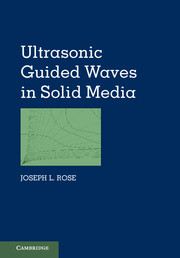Book contents
- Frontmatter
- Contents
- Nomenclature
- Preface
- Acknowledgments
- 1 Introduction
- 2 Dispersion Principles
- 3 Unbounded Isotropic and Anisotropic Media
- 4 Reflection and Refraction
- 5 Oblique Incidence
- 6 Waves in Plates
- 7 Surface and Subsurface Waves
- 8 Finite Element Method for Guided Wave Mechanics
- 9 The Semi-Analytical Finite Element Method
- 10 Guided Waves in Hollow Cylinders
- 11 Circumferential Guided Waves
- 12 Guided Waves in Layered Structures
- 13 Source Influence on Guided Wave Excitation
- 14 Horizontal Shear
- 15 Guided Waves in Anisotropic Media
- 16 Guided Wave Phased Arrays in Piping
- 17 Guided Waves in Viscoelastic Media
- 18 Ultrasonic Vibrations
- 19 Guided Wave Array Transducers
- 20 Introduction to Guided Wave Nonlinear Methods
- 21 Guided Wave Imaging Methods
- Appendix A Ultrasonic Nondestructive Testing Principles, Analysis, and Display Technology
- Appendix B Basic Formulas and Concepts in the Theory of Elasticity
- Appendix C Physically Based Signal Processing Concepts for Guided Waves
- Appendix D Guided Wave Mode and Frequency Selection Tips
- Index
- Plates
- References
8 - Finite Element Method for Guided Wave Mechanics
Published online by Cambridge University Press: 05 July 2014
- Frontmatter
- Contents
- Nomenclature
- Preface
- Acknowledgments
- 1 Introduction
- 2 Dispersion Principles
- 3 Unbounded Isotropic and Anisotropic Media
- 4 Reflection and Refraction
- 5 Oblique Incidence
- 6 Waves in Plates
- 7 Surface and Subsurface Waves
- 8 Finite Element Method for Guided Wave Mechanics
- 9 The Semi-Analytical Finite Element Method
- 10 Guided Waves in Hollow Cylinders
- 11 Circumferential Guided Waves
- 12 Guided Waves in Layered Structures
- 13 Source Influence on Guided Wave Excitation
- 14 Horizontal Shear
- 15 Guided Waves in Anisotropic Media
- 16 Guided Wave Phased Arrays in Piping
- 17 Guided Waves in Viscoelastic Media
- 18 Ultrasonic Vibrations
- 19 Guided Wave Array Transducers
- 20 Introduction to Guided Wave Nonlinear Methods
- 21 Guided Wave Imaging Methods
- Appendix A Ultrasonic Nondestructive Testing Principles, Analysis, and Display Technology
- Appendix B Basic Formulas and Concepts in the Theory of Elasticity
- Appendix C Physically Based Signal Processing Concepts for Guided Waves
- Appendix D Guided Wave Mode and Frequency Selection Tips
- Index
- Plates
- References
Summary
Introduction
The finite element method (FEM), also known as finite element analysis (FEA), is a widely used numerical solution approach for solving problems of wave propagation and vibration. For some complex differential or integral equations without analytical solutions, FEM can provide accurate and computationally efficient solutions that may be improved by refining the elements used in the study. FEM may be combined with analytical analysis or other numerical methods to achieve optimum solutions.
Cook and colleagues (1992) concluded that a successful FEM simulation usually involves the items listed in Table 8.1. Although commercial FEM software has been widely used, the only step commercial software can accomplish is the finite element analysis step. To achieve an accurate FEM simulation, the analyst needs to appropriately understand the physical problem, conduct a basic preliminary study, and select a correct mathematical model. The analyst should also check the calculation results based on either theoretical research or experimental data.
Overview of the Finite Element Method
Using the Finite Element Method to Solve a Problem
Simple geometry, loading, and boundary conditions are required to achieve an exact analytical solution for a field problem. For a complicated problem that cannot be solved analytically while considering if the entire structure can be separated into small, discrete elements with simple loading and boundary conditions, one may simplify this problem as a field problem in each simple element.
Information
- Type
- Chapter
- Information
- Ultrasonic Guided Waves in Solid Media , pp. 120 - 134Publisher: Cambridge University PressPrint publication year: 2014
